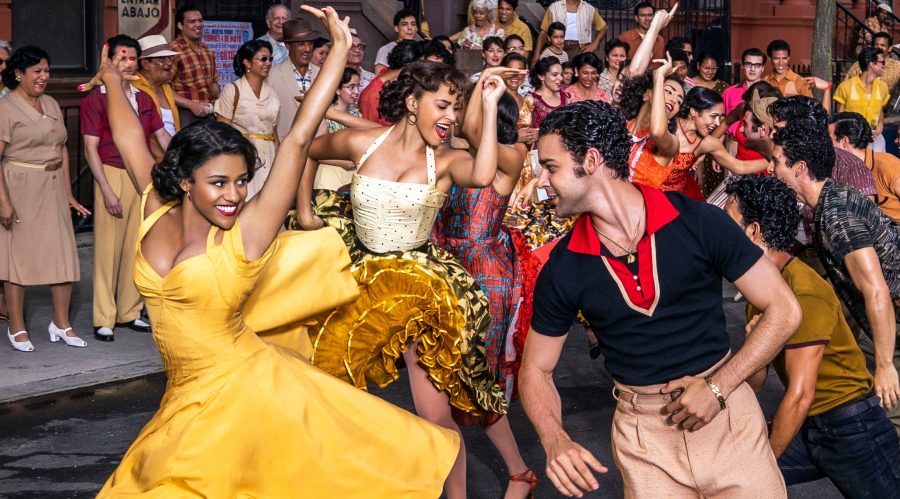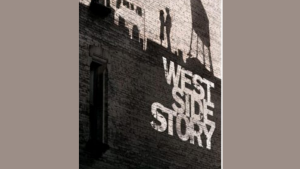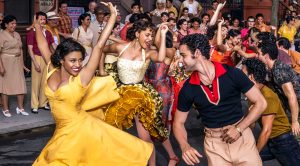‘West Side Story’: The mean streets of…’60s University City?
Published December 15, 2021
We had to have looked absolutely ridiculous, and I say that as a frequent participant.
On weekend evenings in the late fall and winter of 1961 and into the spring of ’62, drivers casually motoring through some of University City, Mo.’s, quietest residential neighborhoods could come around a curve or crest a little hill and find themselves headlights-to-faces with five to 10 boys snapping our fingers in unison, whistling, running, leaping, kicking and spinning together across the pavement as if we owned it.
We owned nothing. Weather-permitting, our antics were just us acting out our enthusiasm for a new movie musical whose stunning dance sequences and youthful storylines had pretty much mesmerized us: “West Side Story.”
Based on the Broadway musical that had premiered in 1957, the movie adaptation opened in New York in mid-October, 1961, two months later in Los Angeles and then in the rest of the country.
I decided to fact-check at least the broad strokes of my ancient memories of “West Side Story” street dancing.
So I called my dear friend of 60-plus years, Ron Podolsky and asked him about it. If there was a leader among us in those days, it surely was Ron, and I remembered him in our street-dancing groups.
He didn’t hesitate a second. “Do you remember those metal ‘horses’ in the street?” he asked, referring to traffic barriers positioned to keep car speeds down. “Harvey Yorke [another friend], was a great acrobat and used to jump over them” during “West Side Story” moments.
Ron, who later was voted the most popular boy in our U. City graduating class by a wide margin, was also a skilled piano player with a great ear and a fine touch. He reminded me that he had worked out and played piano arrangements of such “West Side Story” songs as “Maria” and “Tonight.” “I loved the music, and I loved the movie,” he said.
Let me be honest: Considered logically, our feelings of connection to “West Side Story” really made no sense.
The original movie –- like parts of the 2021 version directed by Steven Spielberg that was released on Friday –- is set and was filmed in working-class and impoverished areas of the Upper West Side of New York, the biggest of America’s big cities.
We, on the other hand, were growing up in middle-class neighborhoods of various income levels in University City, a stable suburb of mid-sized St. Louis.
The broad story of “West Side Story,” meanwhile, revolves around the often-violent competition between two street gangs of supposed teenagers –- the Jets and the Sharks — for dominance on the Upper West Side. On screen, most of the actors who play gang members in the original and new movie versions look to be in their mid-20s to mid-30s.
In contrast, we were 14-to-15-year-olds in 9th grade at Hanley Junior High, the since-torn-down public school for 7th-, 8th- and 9th-graders living in the eastern half of U. City. We didn’t know from street gangs.
Almost everybody in our group of buddies was Jewish. But notwithstanding the movies’ New York setting, the few references to religion invoke Christian denominations, mostly Catholic.
The Jets are tough teens born in the United States with parents who immigrated to America long ago mainly from the countries of western Europe. The Sharks are equally tough, and some have been born in the United States. But many immigrated to America much more recently with their parents from Caribbean spots — Puerto Rico in particular.
Members of both gangs and their families are working-class people struggling economically and fighting discrimination, but the more recent arrivals from Puerto Rico also are the targets of vicious stereotyping, and they haven’t yet accumulated political influence or managed to advance economically.
My U. City pals and I were all born in the United States, as were most of our parents. You’d have to go back to our grandparents for immigration to have been a factor. Our parents continued to try to improve their economic status, and middle-class standing, broadly defined, was reasonably solid in the community.
Even so, all these disconnections didn’t seem to diminish our love of “West Side Story” in 1961. There we were: kids with little to no skill or training in the kind of street-, ballet- and modern-dance moves the movie’s cast was pulling off. But there we were anyway: earnestly, if poorly, trying to emulate those moves on the streets of our sheltered neighborhoods.
We worked against our abundant deficiencies with genuine enthusiasm and appreciation for the on-screen talent that had dazzled us. And truth is, we could argue that we got at least a little better as the weeks went by — in a sub-sub-sub-pro kind of way — and we kept at it.
I think what this suggests is actually the underlying reality of how art gets into us. We 9th-grade Jewish guys who embraced the movie in 1961 to the point of dancing badly in the street did so not because of logic but because it resonated within us emotionally. As I re-discovered last week when I pulled out my high-definition DVD of the 1961 original and turned it up.
As the lengthy music-and-graphic-art prologue kicked in –- absent voices, text or even recognizable still or moving images of any kind –- I began to feel, well, moved.
Later, I don’t think it was exactly the Shakespearean “Romeo and Juliet” tragic storyline — a source for the plot of the stage production and movies — that was getting to me or even the broader story of ill-fated love between a boy and a girl from clashing cultures. Stretching it even further, while it’s surely true that my friends and I had been in the hormone storms of puberty back in 1961, I don’t think the movie was necessarily sparking memories of those challenges and the emotions they set off.
Yet by the time I’d finished watching the 2 ½-hour original movie, I had been reduced to tears not once or three or four times but I’d say seven or eight times. And they weren’t all at sad moments. Sometimes, it was just a progression of chords that got to me, or a change of rhythm or volume or instrumentation by the orchestra, or a passage of dialogue from an unexpected character or an actor’s face with telltale signs of an emotion hitting their heart –- and mine.
There were fewer of these kinds of moments when I saw the new movie at a local theater, but there certainly were some, and I don’t know how to explain the different levels of intensity.
Maybe that 14-year-old kid of long ago could tell me about it.
Eric Mink is a freelance writer and editor and teaches film studies at Webster University. He is a former columnist for the St. Louis Post-Dispatch and the Daily News in New York. Contact him at [email protected].



















